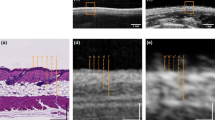Abstract
Environmental ultraviolet (UV) exposure exacts a significant toll annually in terms of overall morbidity and undesirable esthetic effects of skin aging. In order to establish the molecular and pathologic basis of this process, the murine model of ultraviolet B (UVB)-induced aging has long been used with reproducibility and success. Although morphometric and histological endpoints have been useful tools to describe this model historically, they fail to allow for the real time monitoring of the aging process, and do not fully account for effects of the in vivo environment on cutaneous strata with aging. The objective of the present study was to evaluate the ability of high-resolution magnetic resonance imaging (MRI) to characterize the murine model of photoaging throughout the aging process. Six-week-old male nu/nu mice were exposed to narrow-band UVB at 30 min intervals five times weekly for 10 weeks, resulting in a characteristic photoaged morphometric result. MRI scans were performed using a 7 tesla (7 T) small animal imaging platform at pre-exposure baseline at 4 and 10 weeks. Histological analysis of full-thickness biopsies taken in 10 week photoaged mice was correlated with MRI findings, and was compared against control animals receiving no ultraviolet radiation. MRI studies revealed a statistically significant prominent evolution of epidermal hyperplasia at 4 weeks versus baseline and at 10 weeks compared to 4 week values (0.172 ± 0.017 mm versus undetectable, P ≤ 0.05; 0.258 ± 0.007 versus 0.172 ± 0.017 mm, P ≤ 0.05, respectively). A parallel trend of dermal hyperplasia which approached statistical significance was likewise noted at 10 weeks compared to baseline values (0.420 ± 0.073 versus 0.295 ± 0.078 mm, P = 0.06). Histology confirmed the progressive epidermal hyperplastic change characterized by MRI findings. This study validates the novel use of high-resolution MRI for study of the murine photoaging model and establishes its potential to describe progressive cutaneous pathology in such an experimental setting.



Similar content being viewed by others
References
Kligman LH (1996) The hairless mouse model for photoaging. Clin Dermatol 14:183–195
Ma W, Wlaschek M, Tantcheva-Poor I, Schneider LA, Naderi L, Razi-Wolf Z, Schuller J, Scharffetter-Kochanek K (2001) Chronological ageing and photoageing of the fibroblasts and the dermal connective tissue. Clin Exp Dermatol 26:592–599
Machet L, Ossant F, Bleuzen A, Gregoire JM, Machet MC, Vaillant L (2006) [High-resolution ultrasonography: utility in diagnosis, treatment and monitoring dermatologic diseases]. J Radiol 87:1946–1961
Richard S, Querleux B, Bittoun J, Jolivet O, Idy-Peretti I, de Lacharriere O, Leveque JL (1993) Characterization of the skin in vivo by high resolution magnetic resonance imaging: water behavior and age-related effects. J Invest Dermatol 100:705–709
Schafer T, Merkl J, Klemm E, Wichmann HE, Ring J (2006) The epidemiology of nevi and signs of skin aging in the adult general population: results of the KORA-survey 2000. J. Invest Dermatol 126:1490–1496
Trautinger F (2001) Mechanisms of photodamage of the skin and its functional consequences for skin ageing. Clin Exp Dermatol 26:573–577
Acknowledgments
We thank Jorge De La Cerda and Doug Webb of the University of Texas MD Anderson Cancer Center Small Animal Imaging Facilty for their valuable assistance with MRI. We also thank Jackie Furr and Sherita Daniel of the MD Anderson histology laboratory for their excellent assistance with preparation of histological sections and stains.
Author information
Authors and Affiliations
Corresponding author
Rights and permissions
About this article
Cite this article
Altman, A.M., Bankson, J., Matthias, N. et al. Magnetic resonance imaging as a novel method of characterization of cutaneous photoaging in a murine model. Arch Dermatol Res 300, 263–267 (2008). https://doi.org/10.1007/s00403-008-0839-0
Received:
Accepted:
Published:
Issue Date:
DOI: https://doi.org/10.1007/s00403-008-0839-0




